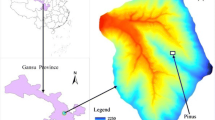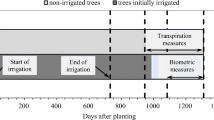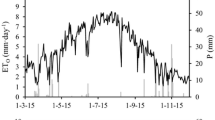Abstract
Given the increasing threat of water shortages in the extremely arid regions (rainfall<50 mm year−1) of northwestern China, growing season evapotranspiration (ET) associated with native species such as Tamarix ramosissima is of particular interest. Consequently, this study sought to evaluate the accuracy of daily ET estimates using Bowen ratio data, as well as measuring seasonal ET and development of an energy balance for a stand of T. ramosissima. Bowen ratio apparatus measurements of ET were carried out on a stand of T. ramosissima in a 2.04 km2 field, which are all covered with T. ramosissima near Erdaoqiao, Ejina Province, Inner Mongolia Autonomous Region, China. Soil moisture content and green area index were also monitored. Daily ET could be accurately estimated from Bowen ratio data on a continuous basis over the 153-day growing season. The mean daily T. ramosissima ET over this period was 1.62 mm day−1, for a seasonal total of 248.20 mm. In this extremely arid locale, the great majority of available energy dissipated over the growing season was a result of sensible rather than latent heat fluxes. While the heat storage term was the main source of energy at night and a considerable sink of energy during the daytime, the magnitude of the daily mean soil heat flux was small. Such a determination of temporal and ecosystem-specific ET patterns allows an improved prediction of ET in the desert riparian zone.








Similar content being viewed by others
References
Angus DE, Watts PJ (1984) Evapotranspiration—how good is the Bowen ratio method? Agric Water Manage 8:133–150
Asktorab H, Pruitt WO, Paw UKT, George WV (1989) Energy balance determinations close to the soil surface using a micro Bowen ratio system. Agric For Meteorol 46:259–274
Baker JM, van Bavel CHM (1987) Measurements of mass flow of water in stems of herbaceous plants. Plant Cell Environ 10:777–782
Bausch WC, Bernard TM (1992) Spatial averaging Bowen ratio system: description and lysimeter comparison. Trans ASAE 35:121–128
Blad BL, Rosenberg NJ (1974) Lysimetric calibration of the Bowen ratio–energy balance method for evapotranspiration estimation in the central Great Plains. J Appl Meteorol 13:227–236
Cellier P, Olioso A (1993) A simple system for automated longterm Bowen ratio measurement. Agric For Meteorol 66:81–92
Cheng L, Qu Y (1992) Water and land resources and their rational development and utilization in the Hexi region (in Chinese). Science Press, Beijing, 420pp
Cooper DI, Eichinger WE, Kao J, Hipps L, Reisner J, Smith S, Schaeffer SM, Williams DG (2000) Spatial and temporal properties of water vapor and latent energy flux over a riparian canopy. Agric For Meteorol 105:161–183
Devitt DA, Piorkowski JM, Smith SD, Cleverly JR, Sala A (1997) Plant water relations of Tamarix ramosissima in response to the imposition and alleviation of soil moisture stress. J Arid Environ 36:527–540
Devitt DA, Sala A, Smith SD, Cleverly J, Shaulis LK, Hammett R (1998) Bowen ratio estimates of evapotranspiration for Tamarix ramosissima stands on the Virgin River in southern Nevada. Water Resour Res 34:2407–2414
Dugas WA, Fritschen LJ, Gay LW, Held AA, Matthias AD, Reicosky DC, Steduto P, Steiner JL (1991) Bowen ratio, eddy correlation, and portable chamber measurements of sensible and latent heat flux over irrigated spring wheat. Agric For Meteorol 56:1–20
Feng Q, Cheng G (1998) Current situation, problems and rational utilization of water resources in arid north–western China. J Arid Environ 40:373–382
Fritschen LJ (1965) Accuracy of evapotranspiration determination by the Bowen ratio method. Bull Int Assoc Hydrol Sci 10:38–48
Fritschen LJ, Simpson JR (1989) Surface energy balance and radiation systems: general description and improvements. J Appl Meteorol 28:680–689
Grant DR (1975) Comparison of evaporation measurements using different methods. Quart J R Meteor Soc 101:543–550
Ham JM, Heilman JL, Lascano RL (1991) Soil and canopy energy balances of a row crop at partial cover. Agron J 83:744–753
Hansen S, Gorbach C (1997) Middle Rio Grande water assessment: final report. US Bureau of Reclamation, Albuquerque Area Office, pp 151
Jackson RB, Carpenter SR, Dahm CN, McKnight DM, Naiman RJ, Postel SL, Running SW (2001) Water in a changing world. Ecol Appl 11:1027–1045
James RC, Clifford ND, James RT, David JG, Julie EAC (2002) Seasonal estimates of actual evapo-transpiration from Tamarix ramosissima stands using three-dimensional eddy covariance. J Arid Environ 52:181–197
Jaral J, Stockle CO, Kjelgaard J (1998) Measurement of evapotranspiration and its components in a corn (Zea mays L.) field. Agric For Meteor 92:131–145
Kjelgaard JK, Stockle CO, Villar Mir JM, Evans RG, Campbell GS (1994) Evaluating methods to estimate corn evapotranspiration from short–time interval weather data. Trans ASAE, 37:1825–1833
Lafleur PM, Rouse WR (1990) Application of an energy combination model for evaporation from sparse canopies. Agric For Meteorol 49:135–153
Malek E, Bingham GE (1993) Comparison of the Bowen ratio–energy balance and the water balance methods for the measurement of evapotranspiration. J Hydrol 146:209–220
McGinn SM, King KM (1990) Simultaneous measurements of heat, water vapor and CO2fluxes above alfalfa and maize. Agric For Meteorol 49:331–349
Prueger JH, Hatfield JL, Aase JK, Pikul JL Jr (1997) Bowen–ratio comparisons with lysimetric evapotranspiration. Agron J 89:730–736
Prueger JH, Hipps LE, Copper DI (1996) Evaporation and the development of the local boundary layer over an irrigated surface in an arid region. Agric For Meteorol 78:223–237
Pruitt WO, Swann BD, Held A, Sutton, Bruce, Matisa A, Hsiao TC (1987) Bowen ratio and Penman: Australian–California tests. In: Irrigation system for the 21st century. Proc Irrig and Drain. Spec. Conf. ASCE, New York, pp149–158
Richard W Todd, Steven R Evett, Terry A Howell (2000) The Bowen ratio-energy balance method for estimating latent heat flux of irrigated alfalfa evaluated in a semi-arid, advective environment. Agric For Meteorol 103:335–348
Sala A, Smith SD, Devitt DA (1996) Water use by Tamarix ramosissima and associated phreatophytes in a Mojave Desert floodplain. Ecol Appl 6:888–898
Soil Conservation Service (1967) Soil survey laboratory methods and procedures for collecting soil samples. Soil survey Investigation Report no 1. USDA US Government Printing Office, Washington, DC, pp 34–78
Todd RW, Evett SR, Howell TA (2000) The Bowen ratio–energy balance method for estimating latent heat flux of irrigated alfalfa evaluated in a semi–arid, advective environment. Agric For Meteorol 103:335–348
Verma SB, Rosenberg NJ, Blad BL, Baradas MW (1976) Resistancy–energy balance method for predicting evapotranspiration: determination of boundary layer resistance and evaluation of error effects. Agron J 68:776–782
Wang G, Cheng G (1999) Water resource development and its influence on the environment in arid areas of China—the case of the Hei River basin. J Arid Environ 43:121–131
Webb EK, Pearman GI, Leuning R (1980) Correction of flux measurements for density elects due to heat and water vapor transfer. Quart J R Meteorol Soc 106:85–100
Acknowledgements
This research was supported by a grant from the Hundred Talent Scholar Foundation (2003401).
Author information
Authors and Affiliations
Corresponding author
Rights and permissions
About this article
Cite this article
Si, J.H., Feng, Q., Zhang, X.Y. et al. Growing season evapotranspiration from Tamarix ramosissima stands under extreme arid conditions in northwest China. Environ Geol 48, 861–870 (2005). https://doi.org/10.1007/s00254-005-0025-z
Received:
Accepted:
Published:
Issue Date:
DOI: https://doi.org/10.1007/s00254-005-0025-z




